 |
Exploring the Horizons of
Mycophagy
on the Olympic Peninsula of Washington
Page 2
|
"With regard to tastes, it is always well to remember that
they are individual; otherwise moths would not eat cloth."
A Word of Caution
I suppose a disclaimer of some sort would be prudent regarding
the theme of this article.
Although I respectfully consider the monumental amount of
experience and wisdom that the readership of this journal
possesses regarding the dangers of experimenting with wild
edibles in general, I sternly warn everyone who may consider
experimental mycophagy: Eating mushrooms of unknown edibility
can result in illness or death. There is no room for a cavalier
attitude nor for intermittent attention to detail. I have
studied a myriad of warnings and case histories on this subject
from a plethora of authorities. I consider myself extremely
fortunate to have never experienced deleterious effects—thus
far. There is that infinitesimal, lingering concern in the far
corner of my psyche regarding possible long-term effects of this
research. But as with mountain climbing, para-sailing, or
stepping outside (even inside) one’s dwelling, there is an
inherent risk involved with every activity. Study. Be careful.
A variety of edibles: |
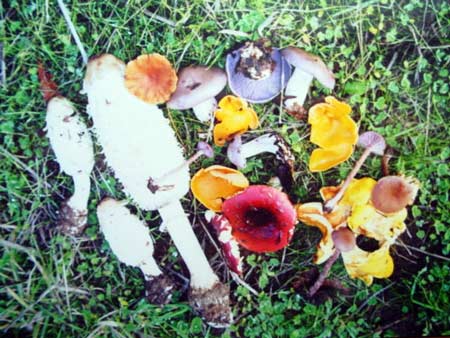 |
| |
|
|
| |
| Evaluate your reasons for doing what you do. I am a
Naturalist by vocation and hobby—I am driven to acquire primary
experiences and then share them. I am not, however, predisposed
to acquiescing when someone attempts to corral my actions based
upon their prejudices or murky, nebulous claims perpetuated by
fear. I am not advocating that you go out and pick the mushrooms
I mention in this article and eat them. I am merely
supplementing the existing literature with my knowledge. I
invoke the words of Roy Chapman Andrews, "Each one of us is a
trustee of the past; we have the task of living up to our
heritage – and adding something to it." Oregon Varnished Conk: |
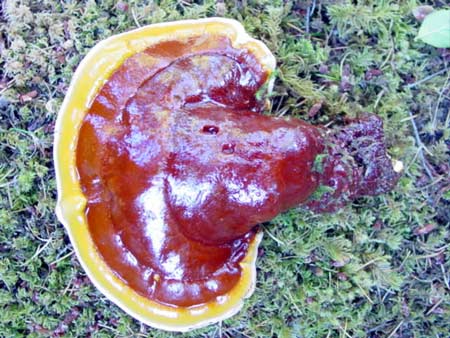 |
| |
|
Methods
What follows is the procedure I use when determining the
edibility of a species of mushroom, whether it is generally
regarded as inedible, hallucinogenic, or unknown. I do not
necessarily endorse your use of this method—I do not know what
will work and be safe for you. This method is constantly
undergoing improvement, so waiting periods can change from
species to species for me and can depend upon the time of day I
start the process. When in doubt—I go without (for a while
longer, anyway)!
1. I am absolutely confident of the specimen’s identity—doubt
can manifest itself physically. Recently I keyed out a specimen
of Tubaria furfuracea, a mushroom generally regarded as
dangerous to eat due to its relation to potentially deadly genus
Galerina and similar appearance to a myriad of other poisonous
LBM’s. When it came time to eat it, I had doubts. So I put it in
the refrigerator and "slept on it." The next morning I went into
the field and collected another couple specimens and keyed them
out to T. furfuracea again, examining the spores, which eased my
doubt and I consumed it in the manner described below. Other
than the acrid-burnt taste, no harm was experienced (cooking
dispels most of the displeasing flavor, however).
2. I consider what the field guides have to say about the
species in question.
3. I eat a dime-sized piece of raw cap on an empty stomach. I
choose to test mushrooms "in the raw" because I think if any
adverse reactions are to occur, this will expedite matters. I’d
rather know sooner than later.
4. I wait about 12 hours.
5. I eat half of the remaining raw cap.
6. I wait about 8 hours.
7. I eat rest of raw cap and stem.
8. I wait about 8 hours.
9. I eat one whole, cooked mushroom on an empty stomach.
10. If I’m better for the experience, then I’ll eat the mushroom
once I encounter it again and give thanks to the aborigines and
the McIlvaines of the world who have done this for us with
hundreds of other species!
At any point during this procedure that I sense ill effects,
I would discontinue the experiment on that species. To date,
I’ve never noticeably suffered from any of these trials.
Dog Vomit Slime Mold: |
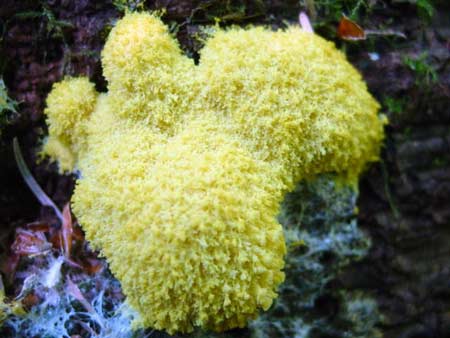 |
| |
| Regarding cooking procedures: I use a skillet (cast iron
preferably) on medium heat that is washed between each frying of
different species. I use no oil, which can impart taste to the
mushroom. For watery specimens, I fry until all excess water has
dissipated. Nary a day goes by (literally) when I do not consume
these mushrooms as meat or tea, for I view this process as a
life-long exploration. Polypores or otherwise tough-fleshed
mushrooms are made into teas and ingested in this fashion
(having filtered out the mushroom solids). Exceptions include
Panus conchatus, Lenzites betula and Poria corticola, which I
pound with a wooden billet to tenderize the flesh to make it
more palatable.
Sessile Earth Star: |
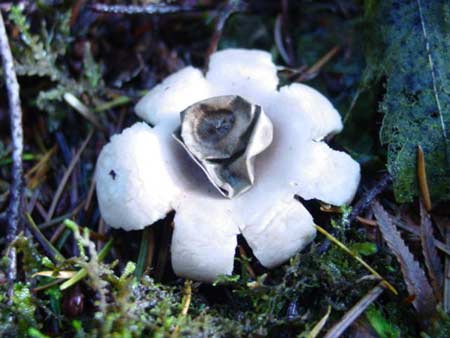 |
| |
"To ask a person to gather his own
mushrooms for the table, without previous instruction that will
enable him to avoid the deadly kinds, is equivalent to, if not
worse than, inviting him to put his unprotected hand into a den
of rattlesnakes."
Tips On Researching About Edible
Mushrooms
Admittedly, my search for information on the edibility of
mushrooms was by no means exhaustive. But this endeavor has
yielded some insights for enhancing one’s mycophagic research
and experimentation:
1. Get to know the half-dozen mushrooms in North America that
are known to be deadly. Especially:
- Death Cap (Amanita phalloides)
- Destroying Angel (Amanita verna , A. ocreata and A. virosa): together
with Death Cap, they comprise 95% of
mushroom poisoning fatalities in the U.S.
- Deadly Galerina (Galerina autumnalis)
- Gyromitra infula (contains the toxin MMH, which is a key ingredient in
rocket fuel!)
- Cortinarius gentilis
- Ringed Cone Head (Conocybe filaris)
2. Consider your sources. Be critical of everything you read.
Everyone has an opinion.
3. Try your best to exhaust available research tools. You may be
surprised by what you discover.
4. Draw your mushrooms while keying them out. It requires you to
pay close attention to their characteristics, which help aid in
their correct identification.
5. Beware of individualized reactions to some mushrooms. Even
though most people can ingest these with impunity, there are
reports of folks suffering intestinal distress as a result of
consuming such species as Blewits (Clitocybe nuda), Sulphur
Shelf (Polyporus sulphureus), Morels (Morchella spp.) and Early
Morel (Verpa bohemica). People falling ill from consuming
Caesar’s Amanita (Amanita caesarea) and Chanterelle (Cantharellus
cibarius) have also been reported.
6. Although recent research has shown that picking certain
mushrooms can stimulate their fertility, conservation can allow
for others to also enjoy your favorite fungi!
Gemmed Puffball: |
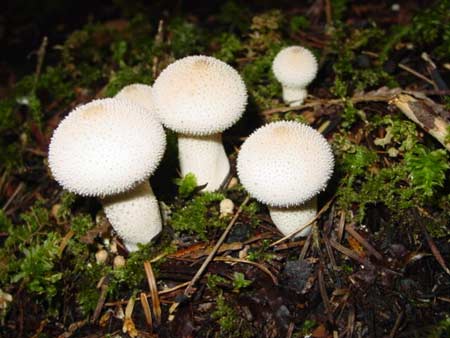 |
| |
A Plea For Unity
Finally, I’d like to address the minor but pervasive
undercurrent within various mycological communities from which
the experimental mycophagist is looked upon with disdain.
Derisive accusations of “exaggeration,” “recklessness,”
“needless heroism,” and having “the foolhearty pretence of
tempting fate” are slung harshly and quite erroneously. While I
can appreciate the need for caution and the responsible
dissemination of information (indeed, some people die each year
from mushroom poisoning), I find it alarming that the sincere
objective of restoring a mostly disintegrated mycogastronomic
record, which serves to further strengthen our biologic ties to
our local landscape, would elicit such acerbic attacks. After
all, mushroom eating seems to me to be only as “dangerous” as
consuming plants. Out of several thousand species, only a
half-dozen mushrooms are considered deadly poisonous. Compare
this to the number of plant species that have been shown to be
toxic. Perhaps the bad rap that has been inflicted upon fungi is
due to our basic fear of the unknown, since mushrooms have been
studied far less than have plants. In this modern world, fear
perpetuated by blind ignorance has given birth to the countless
procession of warnings and disclaimers that inundate us
constantly: We all should recognize ownership of our own
existence. Adventurers and pioneers have forever elevated the
zeitgeist of each successive generation! Let us deconstruct such
ego-barriers, which thwart effective communication and further
injures a world wracked by negativity. Ultimately, we have the
right to decide what we want to do with our lives. Basic human
freedoms….
Please feel free to contact me for any reason. I especially want
to hear from fellow "toadstool testers" and welcome all
comments. Be Well.A good day! |
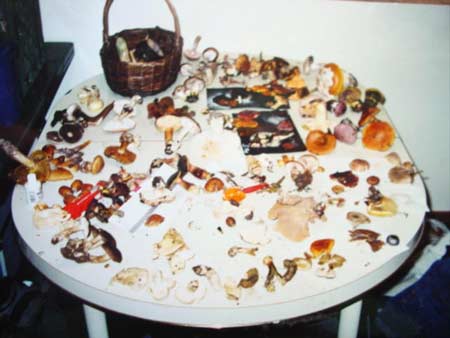 |
| |
Acknowledgements
I thank all of the authors from whom I’ve gleaned
information from through their publications. I humbly compliment
these authorities for their incredible amount of hard work. All
potential errors resulting in my faulty translation of their
words is my fault alone.
I thank Dr. Dennis Desjardin at SFSU to whom I had the honor of
sending a few specimens for confirmation (or, rather,
correction) of identity. I thank Fred Stevens for sharing his
skills and wisdom during a rainy foray in the redwoods of CA.
Most of all, I thank Jeff Stauffer for introducing me to the
wonderful world of fungi.
Pholiota limonella: |
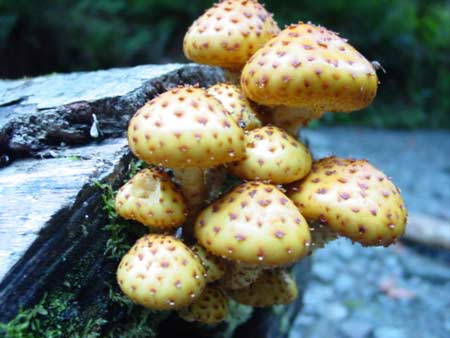 |
| |
|
Back to Page 1 |
| |
| View this article as a PDF |
| |
|
|
|
 |
 |
 |



